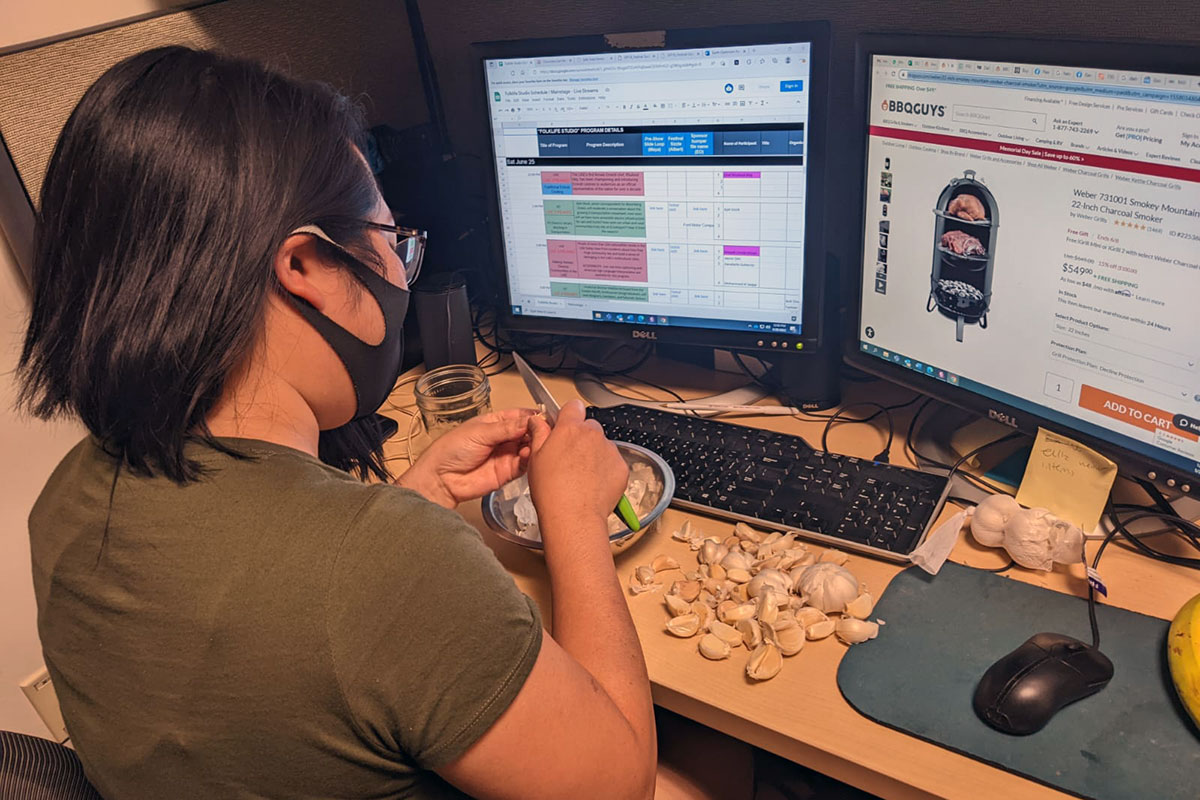Omani Recipe: Date Vinegar

A normal day in the Folklife Festival office: peeling garlic in my cubicle.
Photo by Rebecca Fenton
There is a lot of work involved in putting together the Smithsonian Folklife Festival. Connections to communities and participants are built over months, sometimes years before we even get to the National Mall. In my role as foodways program manager, I usually come in after a participant has been identified by the program curators. Sometimes they are chosen for their specialty dish; other times, for their breadth of knowledge of all things food.
Chef Mommin Al Rawahi, chef and owner of Saaf Authentic Omani Shuwa in Abu Dhabi, was selected to join us to showcase his shuwa, Omani-style pit meat, at the suggestion of his wife, Safiya Al Maskari, a program manager of Lest We Forget, a cultural heritage preservation group and one of our partner organizations in the United Arab Emirates.
Al Rawahi plans on sharing his great-grandmother’s recipe for shuwa. Lamb or goat meat is marinated in khamar al shuwa, خمار الشواء, a wet spice mixture whose recipe varies from family to family, village to village. Once marinated for around five hours or more, the meat is wrapped in banana leaves, then foil, before being put into a shuwa sack, which is woven from dried palm fronds. The whole package is then encaged in wire and lowered into an underground pit heated to 930 degrees Fahrenheit (500 degrees Celsius), or until the bricks turn white.
Once the meat is in, the pit is covered with a lid and sealed with mud for twenty-four hours. Some families like Al Rawahi’s have personal pits in their backyards, but villages also have communal pits that can fit whole animals. The wire cage allows the sack to be lifted out of the pit. The meat, tender and falling off the bone, is served with rice—sometimes plain, sometimes flavored, depending on preference.
As Al Rawahi first described the steps to making the sauce rub (which he makes in forty-pound batches to use all year), he also described making his own fermented date syrup, a process that involves letting the mixture age for forty-five days. As we try to provide our guest chef with the most authentic cooking experience in D.C., it only made sense for me to ferment some date vinegar here myself, as it wouldn’t be an easily sourced item anyways. Al Rawahi does say that apple cider vinegar can be a substitute.

My overzealousness, coupled with a kitchen dominated by roommates, made me think that making this vinegar at my desk in the office would be the most logical way to go. I could easily transport the vinegar to the Festival grounds once it opens, the office would be dark and climate control, and it would be great fun for everyone! Cue the first ever episode of Festival Kitchen: Cubicle Cooking Edition.
Please note that all basic food safety rules were adhered to, and as no heat was used, I also adhered to building safety codes.
However, there was a major snag that I did not anticipate. The jar lids were not fully closed to allow fermenting gases to escape and not explode at my desk. At first, the smell was charming. I had a great story to share, and it just smelled like I had lunch. But by day six, the odor of the mixture had permeated all the hallways in my area, and the strength of the garlic made me the kid with the smelly lunch in the office. It was high school all over again. I was told they had to go.
The jars are safely ageing in my home now, to be transported to the National Mall in mere days for the start of the Festival. With much luck, they will be a nice piece of the UAE waiting for our chefs when they arrive.
Notes from the kitchen: I used four half-gallon mason jars, meaning none were completely filled with liquid based on the recipe. The recipe can of course be scaled up or down, but I wanted to make sure there was room for the fermenting gases to escape.
Date Vinegar
By Mommin Al Rawahi
Ingredients
3.5 liters (14.5 cups) water, room temperature
500 grams (18 ounces) dates, unpitted
225 grams (8 ounces) garlic cloves, peeled
2 tablespoons sea salt
2 tablespoons red chili flakes
Preparation
Fill a large, dark glass jar with a lid with room temperature water. Add the unpitted dates, garlic cloves, sea salt, and red chili flakes. Cover the top of the jar with cheesecloth and secure it close with the lid.
Cover the jar with a dark cloth so no light penetrates through the bottle and store in a dark room for 45 days. Do not check on the mixture before 20 days. When the vinegar is ready, pour through a strainer and cheesecloth.
Al Rawahi adds the vinegar to his spice mixture to marinate the shuwa. Come meet him and see his demonstrations at the Festival to learn more.
Kathy Phung is the foodways program manager for the Smithsonian Folklife Festival. Armed with degrees in anthropology and baking and pastry arts, she has worked in various food enterprises in the D.C. area as a chocolate maker, pastry cook, and butcher.

